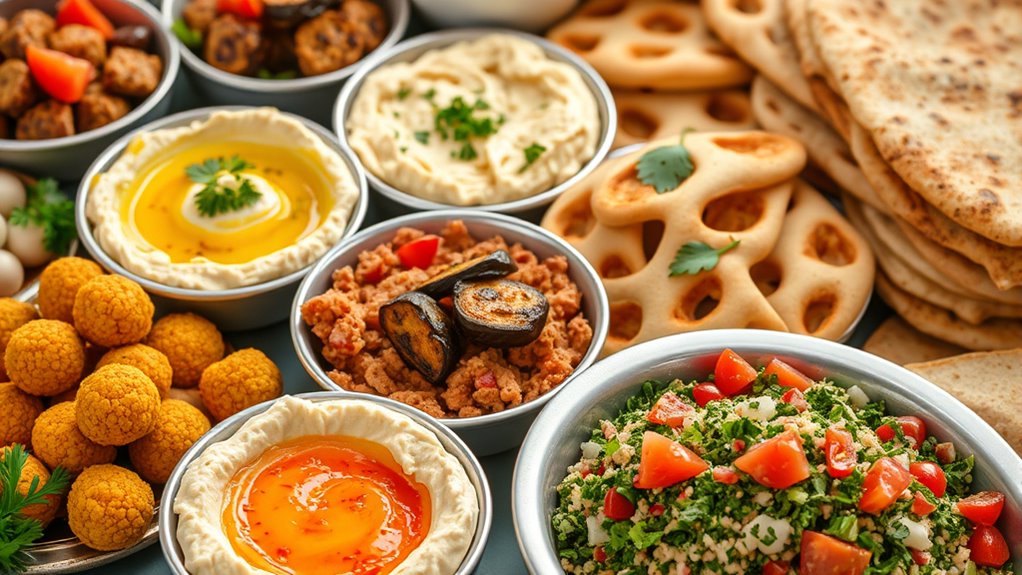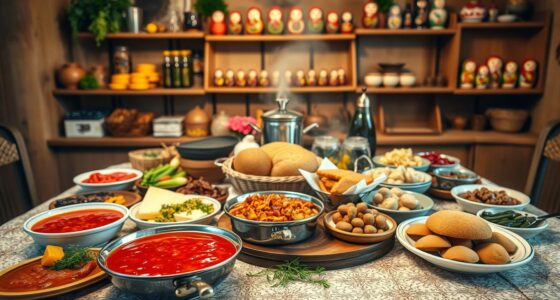To build a balanced Lebanese mezze, combine a variety of dips like hummus, baba ganoush, and labneh with fresh vegetables, salads, and protein options such as falafel or grilled meats. Mix crunchy, creamy, and chewy textures by including pita chips, nuts, and stuffed grape leaves. Add vibrant herbs and colorful garnishes for visual appeal. Keep dietary preferences in mind and craft an attractive, flavorful spread that fosters sharing and community—if you want tips on perfecting your setup, stay tuned.
Key Takeaways
- Incorporate a variety of dips, vegetables, grains, and proteins to ensure flavor, texture, and nutritional balance.
- Use fresh herbs, aromatic spices, and vibrant garnishes to enhance visual appeal and cohesive flavor profiles.
- Create contrast by combining crunchy, creamy, and chewy elements for engaging bites and satisfying mouthfeel.
- Include traditional staples like hummus, labneh, pita, falafel, and fresh salads for authenticity and variety.
- Pay attention to presentation with colorful accents, layered arrangements, and thoughtful garnishes to elevate the overall experience.
Understanding the Core Components of a Lebanese Mezze

Lebanese mezze is a vibrant assortment of small dishes that showcase the country’s rich culinary heritage. When you prepare a mezze, you’ll include a variety of ingredients to create a balanced experience. You’ll find fresh vegetables, herbs, and aromatic spices that highlight Lebanon’s love for bold flavors. Traditional components often include salads, pickles, and grilled items, offering both raw and cooked options. You’ll also incorporate bread, such as pita, to complement the dishes. The goal is to mix textures and tastes—crisp, creamy, tangy, and savory—to excite your palate. While each dish has its unique identity, they all come together to form a harmonious spread that celebrates Lebanese culinary traditions. Incorporating authentic ingredients such as fresh herbs and traditional spices enhances the overall authenticity and flavor profile of your mezze. Paying attention to culinary balance ensures that each dish complements the others, creating a well-rounded and satisfying meal. Additionally, paying attention to presentation and serving can elevate the overall dining experience, making each dish more inviting and appetizing. To achieve an appealing farmhouse aesthetic, consider arranging your mezze on rustic serving platters and using natural garnishes to enhance visual appeal.
Selecting a Variety of Dips and Spreads

When choosing dips and spreads for your mezze, consider a mix of flavors that excite the palate. Aim for a balance between creamy textures and tangy notes to keep things interesting. You can include both traditional favorites and modern twists to cater to all tastes.
Diverse Flavor Profiles
To create a truly memorable mezze experience, selecting a variety of dips and spreads that showcase different flavor profiles is essential. Think beyond classic hummus—include options with bold spices, tangy elements, or smoky undertones. Add a fiery harissa or a cooling tzatziki to bring contrasting tastes to the table. Incorporate vibrant flavors like fresh herbs or roasted vegetables to elevate each dip’s character. Balancing creamy, tangy, spicy, and savory notes guarantees every bite offers something new. Variety keeps your guests engaged and excited to try each dish. Remember, the goal is to create a mosaic of flavors that complement each other and enhance the overall spread, making your mezze both dynamic and delicious. Exploring homesteading skills such as food preservation can also inspire creative ways to prepare and serve your dips.
Balance of Creaminess and Tanginess
Achieving a harmonious mezze spread relies on balancing creamy and tangy dips to satisfy different taste preferences. You want to include options like smooth hummus or labneh for richness, which provide a mellow, velvety texture. Pair these with tangy choices such as yogurt-based dips, pickled vegetables, or lemon-infused spreads that add brightness and acidity. This contrast keeps the spread lively and prevents any single flavor from overpowering others. When selecting dips, consider the overall balance—too many creamy options might feel heavy, while too many tangy ones could be sharp. Aim for a mix that offers both comfort and zest, ensuring every bite provides a delightful interplay of smoothness and tartness that appeals to all guests. Incorporating a variety of color accuracy can also serve as a metaphor for balancing skincare routines, emphasizing the importance of targeted treatment to maintain overall harmony. Understanding how family photoshoot fails often result in humorous moments can remind us to embrace imperfections and enjoy the lively, authentic experience of sharing food. Additionally, paying attention to the visual appeal of each dip can enhance the overall presentation and entice guests to indulge more fully. Furthermore, selecting dips with nutritional benefits can contribute to a healthier, more balanced spread that caters to diverse dietary preferences.
Traditional and Modern Options
Including a mix of traditional and modern dips and spreads adds depth and variety to your Lebanese mezze. Classic options like hummus, baba ganoush, and labneh bring authentic flavors that have stood the test of time. These familiar choices provide a comforting base and showcase Lebanon’s culinary heritage. To elevate your spread, incorporate modern spreads like avocado hummus, spicy harissa, or beet dip. These contemporary twists add visual appeal and new flavor dimensions. Combining both types offers guests a well-rounded experience, catering to different tastes and dietary preferences. Don’t hesitate to experiment with innovative ingredients while respecting traditional roots. This balance keeps your mezze interesting, lively, and inviting, making your gathering memorable and satisfying for everyone.
Incorporating Protein-Packed Items

Adding protein-packed items to your Lebanese mezze not only enhances its nutritional value but also balances flavors and textures. Incorporate ingredients like hummus with chickpeas, falafel, or grilled chicken skewers to provide satisfying bites. Beans, lentils, and boiled eggs are simple yet effective options that add richness and substance. You can also include cheeses such as halloumi or labneh for creaminess and protein. These items complement lighter dips and vegetables, creating a more filling spread. When selecting protein sources, aim for variety to keep the flavors interesting. Incorporating nutritional balance ensures your mezze is not only delicious but also nourishing, making it suitable for sharing and satisfying a range of appetites. Additionally, choosing low carbohydrate foods can help maintain a healthier, balanced meal, especially if you’re mindful of carb intake. To optimize your meal, consider incorporating meal planning principles to ensure the spread covers all essential food groups. For added appeal, consider including diverse designs in your presentation to make the spread more inviting and visually appealing.
Balancing Textures: Crunchy, Creamy, and Chewy
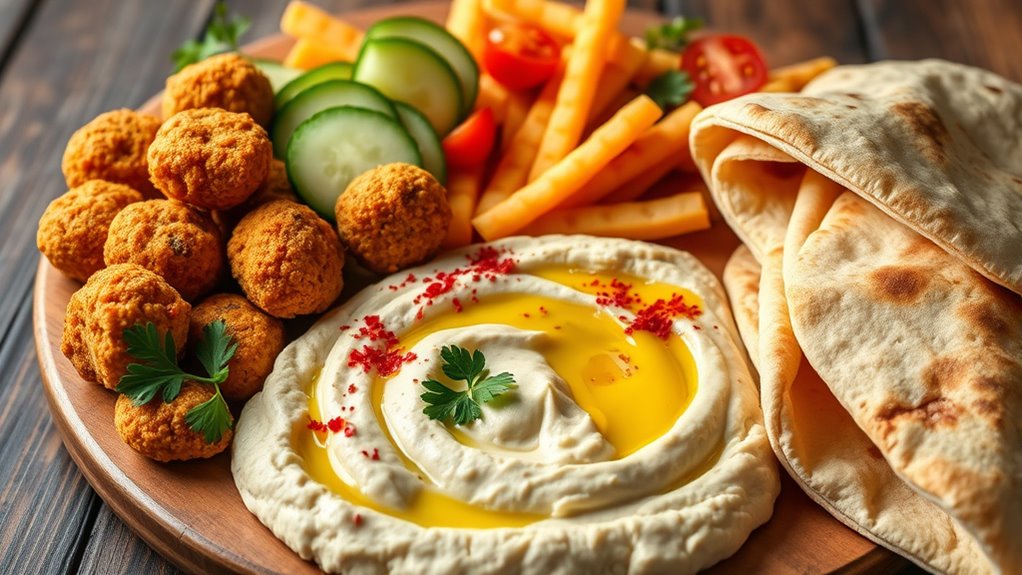
To create a memorable mezze experience, you need to master textural contrast. Combining crunchy, creamy, and chewy elements keeps each bite interesting and satisfying. When you balance these textures thoughtfully, your spread becomes more dynamic and enjoyable. Recognizing the importance of divorce statistics and regional resources can also remind us that variety and balance are key principles, whether in food or in navigating life’s transitions. Incorporating AI security insights can help protect your digital assets, much like how balancing textures ensures a well-rounded dish. Additionally, understanding how to keep devices charged effectively ensures that your digital tools are always ready to support your social and culinary gatherings. Paying attention to tire pressure can also improve your outdoor dining experiences by ensuring comfort and safety during picnics or outdoor gatherings. Maintaining a balanced approach in all these areas reflects the lifestyle for longevity that promotes overall well-being and satisfaction.
Textural Contrast Mastery
Mastering textural contrast is essential to creating an unforgettable Lebanese mezze experience. When you balance crunch, creaminess, and chewiness, each bite becomes more engaging and satisfying. Think of it as crafting a symphony where each element plays a crucial role. To achieve this mastery:
- Combine crispy falafel with smooth hummus for a satisfying crunch and velvety dip.
- Pair chewy muhamara with crunchy fresh vegetables like cucumber or radishes.
- Layer soft labneh with crunchy toasted pita chips for a delightful mix.
- Add a handful of toasted nuts or seeds to creamy spreads for an unexpected texture pop.
- Incorporating angel numbers in food technology can help ensure quality control and prevent contamination, safeguarding both producers and consumers. Additionally, understanding food safety standards is vital to maintaining optimal texture and flavor in mezze preparation. Paying attention to proper storage methods helps preserve the freshness and texture of ingredients, ensuring a balanced and appealing spread. Staying informed about automation in food production can further enhance consistency and quality in your culinary offerings.
Combining Crunch and Cream
Balancing crunch and cream creates a mesmerizing texture contrast that elevates your Lebanese mezze. To achieve this, combine crispy elements like falafel or toasted pita chips with creamy dips such as hummus or labneh. The crunch provides a satisfying bite, while the creaminess offers richness and smoothness. Layering these textures keeps each bite interesting and engaging. You might add a drizzle of olive oil or a sprinkle of herbs on top to enhance both flavors and textures. Be mindful not to overdo the crunch—too much can overpower the delicate creaminess. Instead, aim for a harmony where each component complements the other. This balance makes your mezze more dynamic, inviting your guests to savor each contrasting mouthful. Incorporating a variety of textural elements can further enrich the dining experience by adding depth and interest.
Chewy Elements Balance
Incorporating chewy elements into your Lebanese mezze adds a satisfying layer of texture that complements crunch and cream. These chewy ingredients provide a hearty contrast, making each bite more interesting. To achieve balance, consider these options:
- Kofta or meatballs – tender, dense bites that add substance.
- Stuffed grape leaves (waraq enab) – firm yet tender, offering a natural chewiness.
- Pomegranate seeds – burst with juice, adding a subtle chewiness.
- Sliced grilled eggplant – soft yet slightly fibrous, blending texture seamlessly.
Mixing these with crunchy vegetables and creamy dips creates a dynamic spread that keeps every bite engaging and satisfying. The key is to vary textures thoughtfully, so no element overpowers the others.
Choosing Fresh and Vibrant Vegetables and Salads
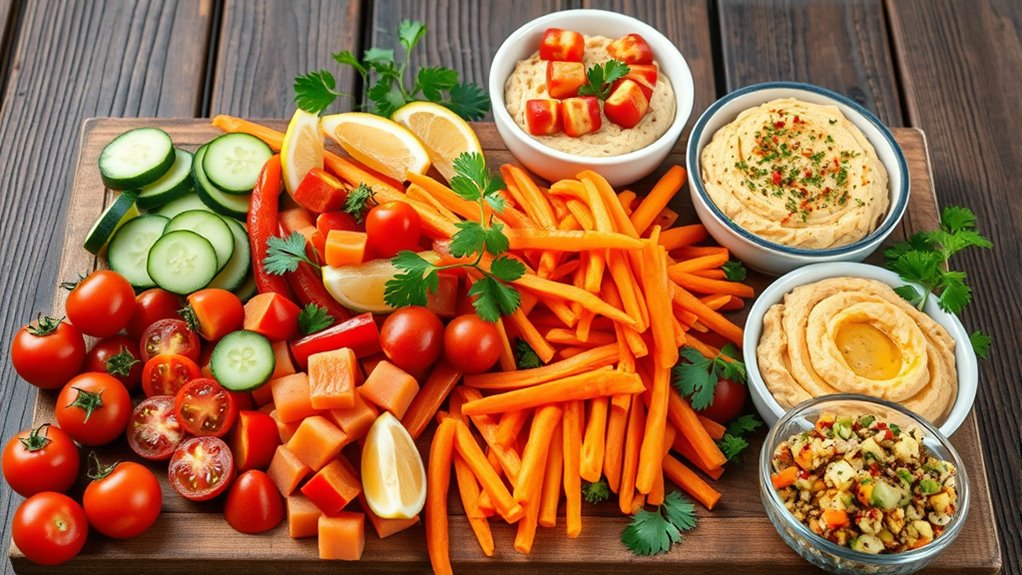
Choosing fresh and vibrant vegetables and salads is essential for creating flavorful Lebanese mezze. When selecting produce, look for bright colors, firm textures, and crispness. Fresh tomatoes, cucumbers, and bell peppers add crunch and juiciness, elevating the overall taste. Incorporate herbs like parsley, mint, and cilantro to add freshness and aroma. Salads such as tabbouleh and fattoush rely on quality ingredients to shine. Avoid wilted or discolored vegetables, as they can dull the flavors. Preparing vegetables just before serving preserves their vibrancy and crunch. Balance is key—combine a variety of textures and flavors to complement other mezze items. By choosing the freshest produce, you ensure each dish bursts with natural flavors and contributes to a lively, appealing spread.
Including Breads and Grains to Complement the Spread
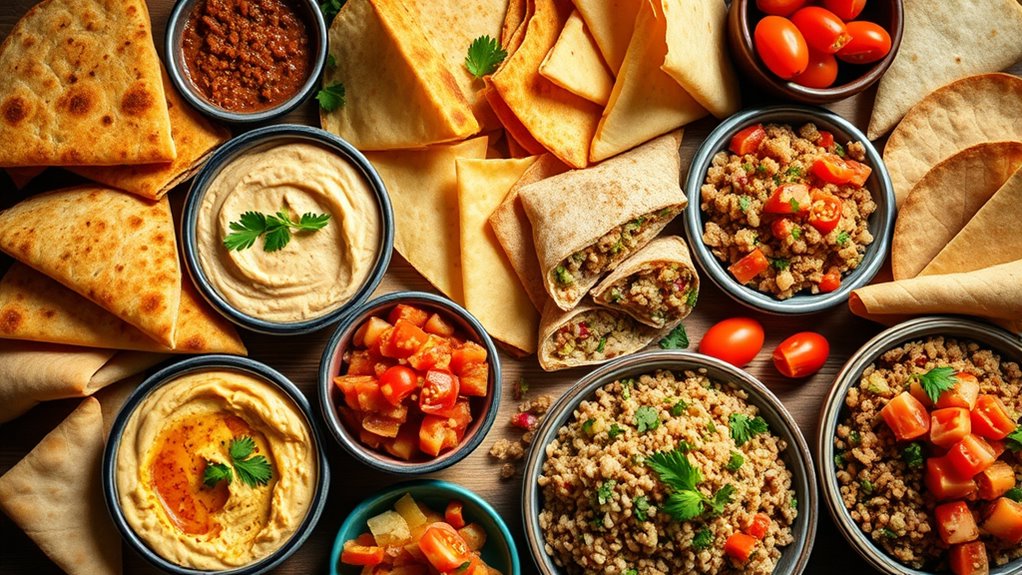
Including breads and grains is essential to rounding out a Lebanese mezze spread, offering both substance and texture. They serve as perfect vehicles to scoop up dips and salads, making every bite more satisfying. You might include:
- Pita bread, soft and warm, ideal for wrapping or dipping.
- Flatbreads like markouk or saj, thin and crispy, perfect for scooping spreads.
- Bulgur or freekeh, cooked and seasoned, adding a hearty grain option.
- Rice pilaf, fragrant with spices and herbs, providing a filling complement.
These elements balance the spread, ensuring variety and depth. Their versatility allows you to enjoy your mezze with different textures and flavors, creating a more complete and enjoyable experience.
Adding Pickles and Preserved Items for Tang and Depth
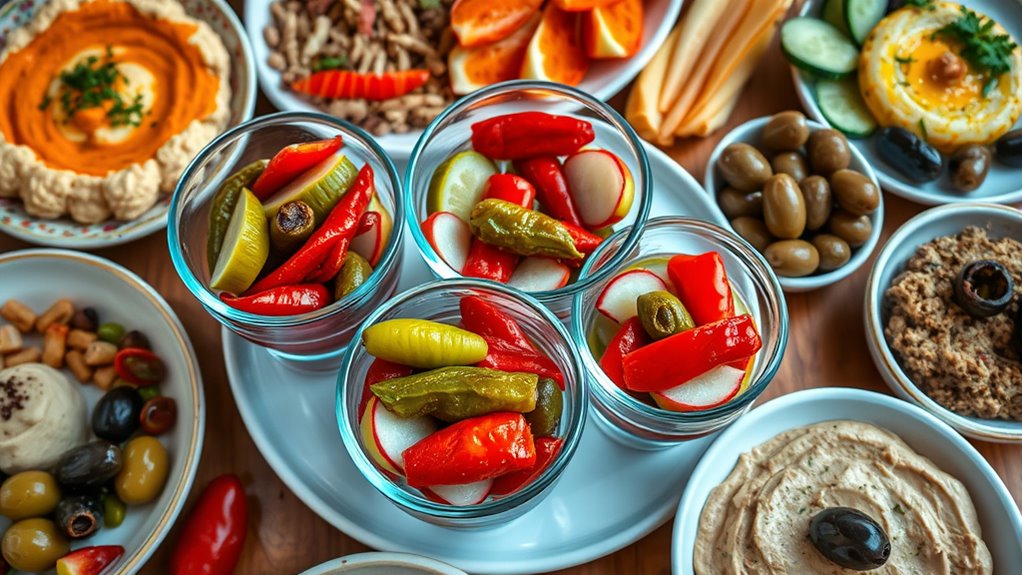
Adding pickles and preserved items introduces a sharp, tangy contrast that enhances the flavors of your mezze. These items cut through richer dishes and balance creamy hummus or smoky baba ganoush with their acidity. Choose a variety of pickles, like crisp cucumbers, tangy turnips, or spicy peppers, to add layers of flavor. Preserved lemons or olives also bring depth and a salty, citrusy note that complements other ingredients. Incorporate these items strategically, placing them near dips and spreads to encourage pairing. The acidity refreshes the palate and prevents the spread from becoming too heavy, keeping your mezze lively and engaging. Remember, a few well-chosen preserved items can elevate your spread by adding complexity and a vibrant burst of flavor.
Arranging Your Mezze for Visual Appeal and Accessibility
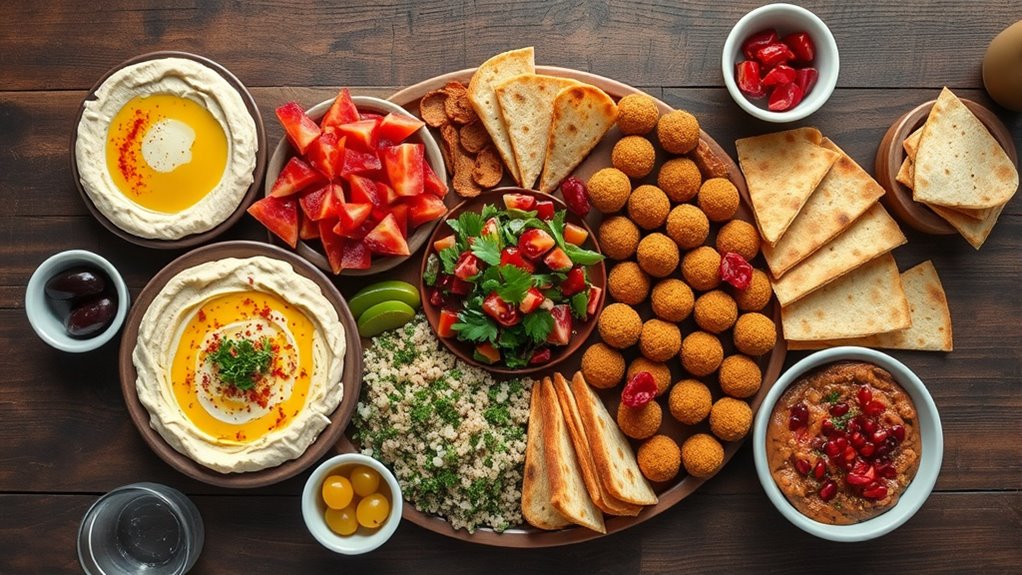
To create an inviting mezze spread, focus on arranging your dishes in a way that’s both visually appealing and easy for guests to access. Start by placing larger, centerpiece items toward the back or center of the table, so they don’t block smaller dishes. Use varying heights—stack bowls or add small stands—to add visual interest. Keep similar items grouped together, like dips or salads, to help guests quickly find what they want. Incorporate color contrasts by mixing vibrant vegetables and herbs with neutral dishes. Finally, leave enough space between items to allow easy serving and movement.
Arrange dishes with height variation, group similar items, and leave space for easy access.
Here’s a quick guide:
- Place large, eye-catching dishes at the back or center.
- Use stands or stacks for height variation.
- Group similar items for easy access.
- Leave gaps for serving and movement.
Tips for Accommodating Dietary Preferences and Restrictions
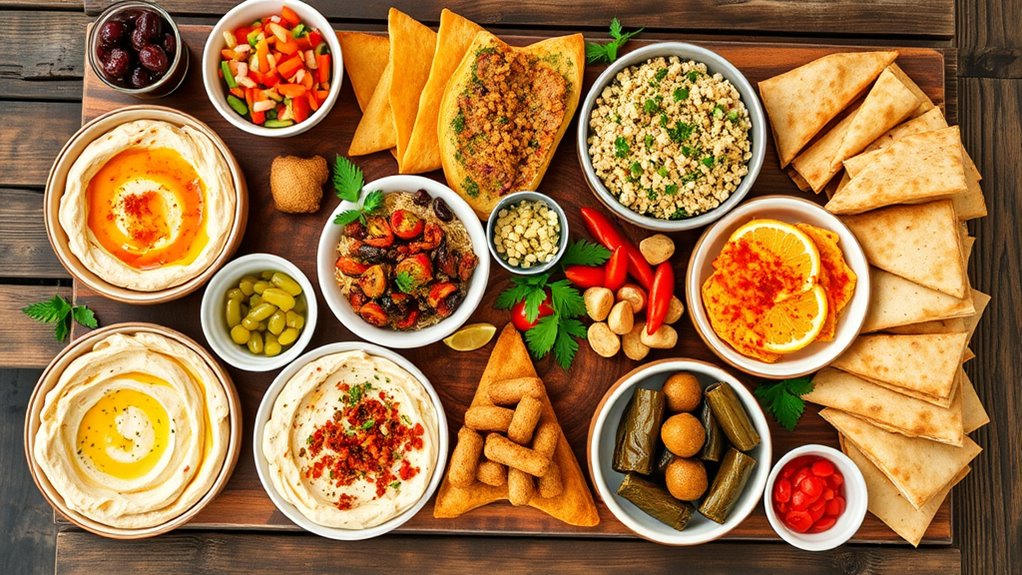
When planning your Lebanese mezze, it’s essential to consider your guests’ dietary preferences and restrictions to guarantee everyone feels comfortable and included. Start by asking about allergies, vegetarian or vegan diets, and religious restrictions like halal or kosher. Offer a variety of dishes that cater to different needs, such as hummus and baba ganoush for vegans, grilled vegetables, or seafood options. Label dishes clearly to help guests identify suitable choices easily. Incorporate plant-based proteins like falafel or lentil salads to accommodate vegetarians. Be mindful of ingredients like dairy, nuts, or gluten, and prepare alternative options if needed. By thoughtfully including diverse choices, you create an inviting atmosphere where everyone can enjoy the feast comfortably.
Final Touches: Garnishes, Herbs, and Presentation Tips

Enhancing your Lebanese mezze with thoughtful garnishes, fresh herbs, and appealing presentation can elevate the entire dining experience. First, sprinkle chopped parsley, mint, or sumac over dishes to add vibrant color and flavor. Second, arrange dips like hummus or baba ganoush in shallow bowls and drizzle with olive oil for a polished look. Third, add lemon wedges, radish slices, or pomegranate seeds as eye-catching accents. Fourth, use small, decorative plates and arrange items symmetrically to create a balanced, inviting spread. These simple touches make your mezze visually appealing and more appetizing. Remember, presentation enhances the overall enjoyment, so take a moment to thoughtfully arrange each element for a stunning, memorable presentation.
Frequently Asked Questions
How Do I Customize a Lebanese Mezze for Vegetarians?
To customize a Lebanese mezze for vegetarians, you focus on plant-based dishes that are flavorful and satisfying. You can include hummus, baba ganoush, tabbouleh, fattoush, stuffed grape leaves with rice, falafel, and fresh vegetables like cucumbers, tomatoes, and olives. You might also add labneh, pickles, and pita bread. By combining these, you create a vibrant, diverse spread that’s filling and true to the essence of Lebanese cuisine.
What Beverages Pair Well With Lebanese Mezze?
When choosing beverages for Lebanese mezze, consider invigorating options that complement the flavors. You might opt for crisp white wines or light rosés to balance the richness of dips and grilled vegetables. Sparkling water with a twist of lemon or mint works well too, offering a cooling contrast. For non-alcoholic choices, try traditional Ayran or fresh citrus juices. These drinks enhance your mezze experience without overpowering the vibrant flavors.
How Can I Make My Mezze More Authentic?
To make your mezze more authentic, focus on using traditional ingredients and techniques. Incorporate fresh herbs like parsley, mint, and sumac, and choose quality olive oil. Prepare classic dishes such as hummus, baba ganoush, and tabbouleh from scratch. Serve everything with warm pita bread and arrange the spread beautifully. Authenticity also comes from sharing the mezze with friends or family, embracing the communal spirit of Lebanese dining.
Are There Regional Variations in Lebanese Mezze?
Did you know that regional variations in Lebanese mezze reflect the country’s diverse climates and cultures? In coastal areas, you’ll find more seafood-based dishes, while mountain regions favor hearty, grain-filled options. You can explore these differences by trying dishes like sayadieh in the north or tabbouleh from Beirut. Embracing these regional flavors will enrich your mezze experience, making it more authentic and vibrant.
How Do I Store Leftover Mezze Items Properly?
To store leftover mezze items properly, you should transfer each item into airtight containers to keep them fresh and prevent odors from spreading. Refrigerate perishable items like hummus, baba ganoush, and salads within two hours of serving. For longer storage, consider freezing items like falafel or grape leaves. Label containers with dates and consume leftovers within three to four days for the best taste and safety.
Conclusion
As you assemble your mezze, think of it as a vibrant canvas and a comforting feast—bright vegetables and zesty pickles contrast with creamy dips and crunchy bites. By balancing colors, textures, and flavors, you create an inviting spread that’s both visually stunning and satisfying to the palate. Embrace the harmony of variety and presentation, turning your mezze into a lively, delicious celebration that delights every sense.
